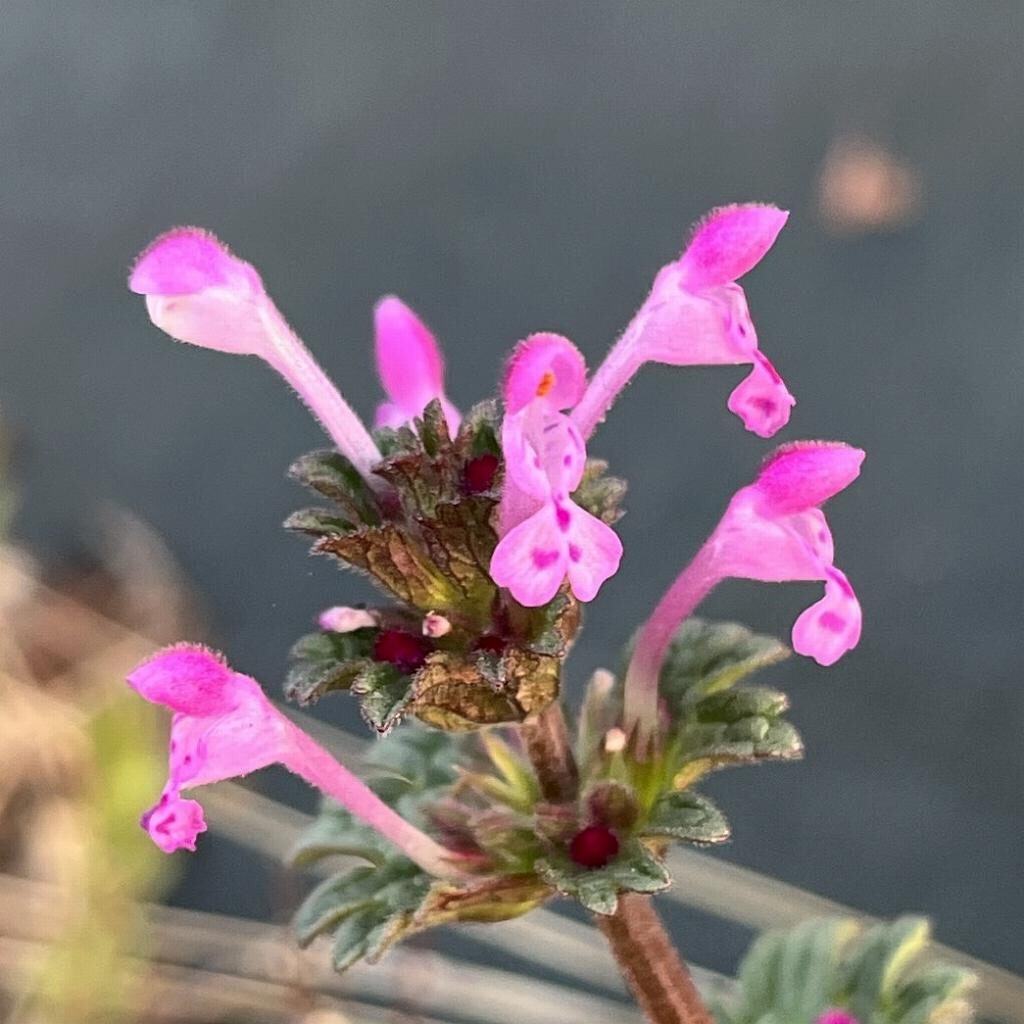ホトケノザの名前の由来は茎を襟巻きのように囲む葉が仏像の台座に似ているから。昔は子どもたちが花を抜き取り、蜜を吸って遊びました。
The Japanese name of Henbit means where Buddha sits, that comes from the fact that the leaves surrounding the stem resemble a pedestal of a Buddha statue. In the olden days, children picked flowers and played with nectar.
【仮名】ホトケノザ, サンガイグサ
【和名】仏の座, 三階草
【英名】Henbit
【学名】Lamium amplexicaule
【誕生】02/ 08
【開花】02, 03, 04, 05, 06月
【花色】White, Pink



ホトケノザ
ホトケノザの来歴
ホトケノザはシソ科オドリコソウ属の越年草。日本では本州、四国、九州、国外ではアジア、欧州、北アフリカに分布しています。田畑の畦畔や道端など、日当たりの良いところに群生。花は頂部の葉腋に輪生し、赤紫色の唇形花を上向きに咲かせます。花言葉は「調和」「輝く心」。
ホトケノザの名前
ホトケノザの名前の由来は、茎を襟巻きのように囲む葉が仏像の台座に似ているから。その葉が段々に着くことから「三階草」とも呼ばれます。ラテン語の属名ラミウムは「喉」を意味し、細長い萼筒に由来。種小名アンプレキシカウレは「茎を抱く」という意味で、葉に由来します。
ホトケノザの姿形
ホトケノザの茎は断面が四角形。葉は対生の扇形で鋸歯が入ります。花は萼筒が細長く、雄しべが4本。昆虫の重みで上下の唇が開いて受粉しますが、蕾のまま結実する閉鎖花もあります。花後の種子は蟻が好む脂肪酸、アミノ酸、糖などを含む「種枕」が付着。遠くまで運ばれます。
ホトケノザの近縁
ホトケノザと同属の近縁種「姫踊り子草」も似た花を咲かせます。ただし、葉はハート形で、隙間なく垂れ下がり、下方が緑色、上方が赤紫色。花は上方の葉の脇から外側に向かって放射状に咲きます。そのほか、草丈の高い「踊り子草」、葉縁が深く切れ込む「紅葉姫踊り子草」も。
ホトケノザの利用
ホトケノザは食用に適さないものの、萼筒の奥に花蜜を湛えるため、昔は子どもたちが花を抜き取り、甘い蜜を吸って遊びました。一方、春の七草で若い葉が食べられる「仏の座」は別の植物で、キク科ヤブタビラコ属の「小鬼田平子」のこと。本州以南の湿ったところに群生します。
Henbit
History of Henbit
Henbit is a biennial plant belonging to the Lamiaceae family. It is distributed in Honshu, Shikoku, and Kyushu in Japan, and in Asia, Europe, and North Africa outside of Japan. It grows in colonies in sunny places such as the ridges of fields and roadsides. The flowers are whorled in the leaf axils at the top, and reddish-purple lip-shaped flowers bloom upward. The flower language is “harmony” and “shining heart”.
Name of Henbit
The Japanese name of Henbit means where Buddha sits, that comes from the fact that the leaves surrounding the stem resemble a pedestal of a Buddha statue. It is also called “three-story grass” because its leaves are stepped. The Latin genus name Lamium means “throat” and derives from the elongated calyx tube. The specific epithet amplexicaule means “embracing the stem” and is derived from the leaves.
Appearance of Henbit
The stem of Henbit has a square cross section. The leaves are fan-shaped and have saw teeth. The flowers have an elongated calyx tube and four stamens. The weight of the insect opens the upper and lower lips for pollination, but there are also closed flowers that bear fruit as buds. After flowering, the seeds are attached with an “elaiosome” containing fatty acids, amino acids, sugars, etc. that ants like, carried long distances.
Relative of Henbit
“Lamium purpureum”, a closely related species of the same genus as Henbit, also has similar flowers. However, the leaves are heart-shaped, drooping tightly, green at the bottom and reddish purple at the top. The flowers bloom radially outward from the sides of the upper leaves. In addition, there are also tall “Lamium album” ,and “Lamium hybridum” with deeply cut leaf edges.
Use of Henbit
Henbit is not edible, but because the calyx is filled with nectar, children used to pick the flowers and play with the sweet nectar. On the other hand, although there is a plant with the same Japanese name, which is one of the seven herbs of spring and whose young leaves are edible, it is a different plant of the Asteraceae family “Lapsanastrum apogonoides”. It grows in colonies in moist areas south of Honshu.


